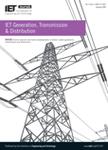版权所有:内蒙古大学图书馆 技术提供:维普资讯• 智图
内蒙古自治区呼和浩特市赛罕区大学西街235号 邮编: 010021

作者机构:Univ Kashan Dept Elect Engn Kashan Iran IIT Dept Elect & Comp Engn Chicago IL 60616 USA
出 版 物:《IET GENERATION TRANSMISSION & DISTRIBUTION》 (IET发电,输电与配电)
年 卷 期:2020年第14卷第16期
页 面:3322-3331页
核心收录:
主 题:distribution networks distributed power generation power consumption power system restoration power system interconnection power generation scheduling power generation control power distribution control distribution network self-healing problem two-stage cyber communication network architecture local control system local power consumption consensus algorithm benchmark distribution networks consensus-based operational framework multimicrogrid systems power networks smart grids multiMG system MMG electrical network constraints self-healing support radial interconnected MG LCS
摘 要:Recently, microgrids (MGs) present a vital role in the transformation of the existing power networks to the smart grids. Connecting MGs to construct the multi-microgrid (MMG) system enhances the robustness of the system against disturbances and upgrades overall network performance. In this paper, the MMG, as a source of self-healing support to the distribution networks, is analysed extensively. In fact, the MMG strengthens the self-healing of the network by participating in the restoration of disturbed loads. In this study, an operational framework is proposed for the self-healing problem in radial interconnected MGs based on two-stage cyber communication network architecture. In the first stage, the local control system (LCS) within each MG, schedules the accessible resources according to the local power consumption target. In the second stage, a number of LCSs are communicated globally to perform self-healing action. The communication of LCSs is accomplished using a consensus algorithm. Nevertheless, when a fault takes place in MG and a line is eliminated, the healthy MGs, due to demand and supply information in the first stage, supply the on-outage loads as far as possible. To validate the effectiveness of the proposed framework, two benchmark distribution networks (the 33-bus and the 119-bus) are employed.